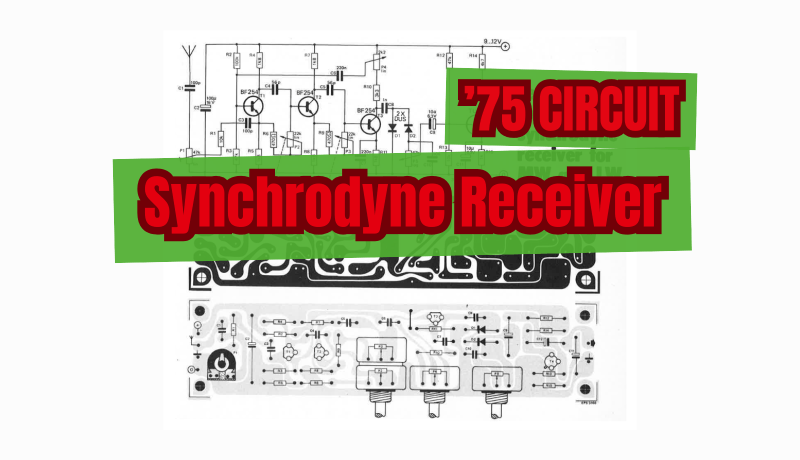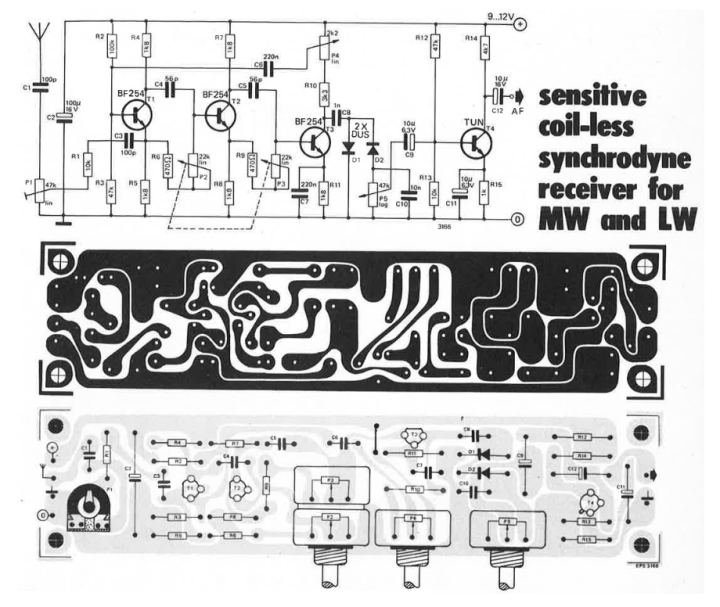Circuito: Ricevitore Synchrodyne Senza Bobina per MW e LW
01 agosto 2025
su
su

Discover a clever 1970s AM radio design that tunes MW and LW without a single coil. This vintage synchrodyne receiver uses a synchronized oscillator for surprisingly sensitive, high-quality reception with minimal components.
 “P4 sets the level of oscillation; the stereo-ganged pair P2 and P3 form the 'tuning' control,” Elektor explained at the time. “Since this stereo potentiometer covers a very wide range it may be necessary to add a 'fine' control consisting of a low-value stereo potentiometer in series (typically 1 k or 500 ohm). The modulated oscillator signal is passed to the amplifier stage with T4, via the full-wave 'detector' with D1 and D2. The output level is sufficiently high for driving most amplifiers.”
“P4 sets the level of oscillation; the stereo-ganged pair P2 and P3 form the 'tuning' control,” Elektor explained at the time. “Since this stereo potentiometer covers a very wide range it may be necessary to add a 'fine' control consisting of a low-value stereo potentiometer in series (typically 1 k or 500 ohm). The modulated oscillator signal is passed to the amplifier stage with T4, via the full-wave 'detector' with D1 and D2. The output level is sufficiently high for driving most amplifiers.”
A simple wire antenna was sufficient to achieve decent reception, the editorial team explained. If a more efficient antenna was used, P1 could be added to avoid overloading the circuit with a strong signal.
First patented in the 1920s, it was an early attempt to enhance selectivity and reduce distortion in AM and SSB signal reception. The receiver generates a local oscillator signal that is ideally synchronized in frequency — and sometimes phase — with the incoming RF signal. While offering high theoretical precision, Synchrodyne receivers were complex and sensitive to oscillator drift, and as a result their practical use was limited. While eventually replaced by improved technology, the Synchrodyne receiver played a key role in the history of radio engineering.
Today's Elektor community members will find the Synchrodyne receiver to be a fascinating historical example of engineering ingenuity. It connects to modern concepts like SDR, direct-conversion receivers, and phase-locked loops (PLLs), which are topics Elektor covers with enthusiasm.
Editor's Note: This article originally appeared in a 1975 edition of ElektorMag. Some components or products might no longer be available, and some design techniques might seem antiquated. However, we believe the project will inspire you to start interesting new electronics projects of your own.
The Synchrodyne Receiver Circuit
First presented in the July/August 1975 edition of Elektor, the compact receiver tunes the medium and long wave ranges. It operates without any coils by employing a synchronized oscillator. When the oscillator is barely able to maintain oscillations, it will synchronize to an incoming signal frequency close to its free-running value. The amplitude of the oscillation follows — more or less linearly — the modulation of the incoming signal. The circuit can synchronize itself to a signal of some tens of microvolts, so that its effective sensitivity is very high.
A simple wire antenna was sufficient to achieve decent reception, the editorial team explained. If a more efficient antenna was used, P1 could be added to avoid overloading the circuit with a strong signal.
What Is a Synchrodyne Receiver?
The term was familiar to Elektor readers in the 1970s. A Synchrodyne receiver is a type of radio receiver that uses homodyne detection to directly convert an incoming RF signal to baseband, bypassing the need for an intermediate frequency (IF) stage.First patented in the 1920s, it was an early attempt to enhance selectivity and reduce distortion in AM and SSB signal reception. The receiver generates a local oscillator signal that is ideally synchronized in frequency — and sometimes phase — with the incoming RF signal. While offering high theoretical precision, Synchrodyne receivers were complex and sensitive to oscillator drift, and as a result their practical use was limited. While eventually replaced by improved technology, the Synchrodyne receiver played a key role in the history of radio engineering.
Today's Elektor community members will find the Synchrodyne receiver to be a fascinating historical example of engineering ingenuity. It connects to modern concepts like SDR, direct-conversion receivers, and phase-locked loops (PLLs), which are topics Elektor covers with enthusiasm.
The Original Project
The original article, “Sensitive Coil-Less Synchrodyne Receiver for MW and LW,” appeared in Elektor July/August 1975. You can read the article for free during the two-week period following the publication of this news item. If you develop an interesting circuit of your wown, please share your progress on the Elektor Labs platform!Editor's Note: This article originally appeared in a 1975 edition of ElektorMag. Some components or products might no longer be available, and some design techniques might seem antiquated. However, we believe the project will inspire you to start interesting new electronics projects of your own.
Registrazione
Iscriviti per ricevere e-mail di avviso sui tag riguardanti Circuits & Circuit Design! Leggi l'articolo completo
Nascondi l'articolo completo









Commenti (1 commenti)